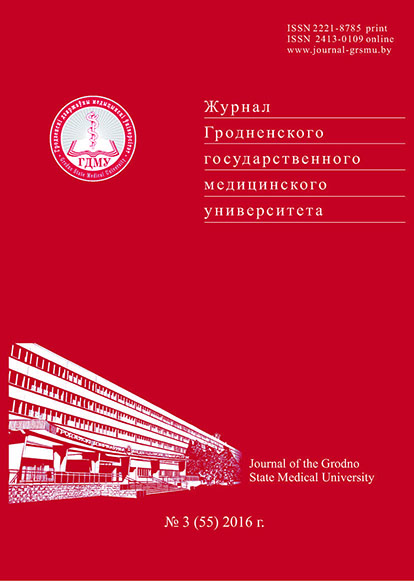ХЕМОСЕНСОРЫ НУТРИЕНТОВ В ПИЩЕВАРИТЕЛЬНОМ ТРАКТЕ

Аннотация
В статье представлены литературные данные о молекулярных механизмах детекции аминокислот, олигопептидов, сладких молекул, жирных кислот и их производных в пищеварительном тракте. Охарактеризован рецепторный аппарат энтероэндокринных клеток и основные пути трансдукции сигнала. Продемонстрировано, что важная роль в детекции принадлежит транслоказам нутриентов. На основе хемосенсорной информации энтероэндокринные клетки регулируют биосинтез и высвобождение кишечных пептидов – холецистокинина, глюкагоноподобного пептида, глюкозозависимого инсулинотропного пептида, гастрина, пептида YY. Последние регулируют секреторную и двигательную активность желудочно-кишечного тракта, гомеостаз глюкозы, энергетический статус организма и пищевое поведение. Специфические рецепторы и транслоказы нутриентов представляют интерес с точки зрения создания фармакологических препаратов, предназначенных для лечения заболеваний пищеварительного тракта, метаболических нарушений, в том числе ожирения и диабета 2-го типа.Литература
Bindels, L. B. GPR43/FFA2: physiopathological relevance and therapeutic prospects/ L. B. Bindels, E. M. Dewulf, N. M. Delzenne//Trends in Pharmacological Sciences.- 2013.- Vol. 34, N4.- P. 226-232.
Functional expression of the extracellular-Ca2+-sensing receptor in mouse taste cells/ M. F. Bystrova [et al.] // J Cell Sci. - 2010. - Vol.123. - P. 972-982.
The GPCR, class C, group 6, subtype A (GPRC6A) receptor: from cloning to physiological function/ C. Clemmensen// British Journal of Pharmacology. - 2014. - Vol.171, N5. - P. 1129–1141.
Conigrave, A. D. Calcium-sensing receptor (CaSR): pharmacological properties and signaling pathways/ A. D. Conigrave, D. T. Ward// Best Pract Res Clin Endocrinol Metab. - 2013. - Vol.27, N3. - P.315-331.
Gut Hormone Pharmacology of a Novel GPR119 Agonist (GSK1292263), Metformin, and Sitagliptin in Type 2 Diabetes Mellitus: Results from Two Randomized Studies/ J. Derek [et al.]// PLoS One.- 2014.- [Electronic resource].- Mode of access: http://www.ncbi.nlm.nih.gov/pmc/articles/PMC3974707/.- Date of access: 02.03.2016.
DiPatrizio, A. Intestinal lipid-derived signals that sense dietary fat/A. Dipatrizio, V. Nicholas, P. Daniele // J Clin Invest 125.3 (Mar 2015): 891-898.
Freeman, H. J. Clinical relevance of intestinal peptide uptake/H. J. Freeman// World J Gastrointest Pharmacol Ther. - 2015. - Vol.6,N2. - P.22–27.
The gut as a sensory organ/ J. B. Furness [et al.]// Nat. Rev. Gastroenterol. Hepatol. - 2013. - Vol.10,N3. - P.729–740.
Metabotropic glutamate receptor type 1 in taste tissue / A. S. Gabriel [et al.]// Am J Clin Nutr. - 2009. - Vol. 90,N3. - P.743-746.
Gustatory sensory cells express a receptor responsive to protein breakdown products (GPR92)/ D. Haid [et al.] // Histochem Cell Biol. - 2013. - Vol.140,N2. - P.137-145.
IUPHAR/BPS Gide to Parmacology [Electronic resource].- Mode of access: http://www.guidetopharmacology. org/GRAC/ReceptorFamiliesForward? type=GPCR.-Date of access: 02.03.2016.
Sugar absorption in the intestine: the role of GLUT2/ G.L. Kellet [et al]//. - Annu Rev Nutr. - 2008. - Vol. 28. - P. 35-54.
Kojima, I. The Role of the Sweet Taste Receptor in Enteroendocrine Cells and Pancreatic β-Cells/ I. Kojima, Y. Nakagawa// Diabetes Metab J. - 2011. - Vol. 35, N5. - P. 451–457.
Molecular Mechanisms of Glucose-Stimulated GLP-1 Secretion From Perfused Rat Small Intestine/ R. E. Kuhre [et al.]// Diabetes. - 2015. - Vol. 64,N2. - P. 370-382.
Laffitte, A. Functional roles of the sweet taste receptor in oral and extraoral tissues / A. Laffitte, A. F. Neiers, L. Briand // Curr Opin Clin Nutr Metab Care. - 2014. - Vol. 17, N4. - P. 379–385.
Enteroendocrine cells: a review of their role in brain-gut communication/R. Latorre [et al.] // Neurogastroenterol Motil. 2015.- [Electronic resource]- Mode of access: http:// onlinelibrary.wiley.com/doi/10.1111/nmo.12754/ abstract?us erIsAuthenticated=false&deniedAccessCustomisedMessage= Date of access: 02.03.2016.
CD36 involvement in orosensory detection of dietary lipids, spontaneous fat preference, and digestive secretions/ F. Laugerette [et al.]// J Clin Invest. - 2005. - Vol.115, N11. - P. 3177–3184.
Protein hydrolysate-induced cholecystokinin secretion from enteroendocrine cells is indirectly mediated by the intestinal oligopeptide transporter PepT1/ A. Liou [et al.]// American Journal of Physiology. - 2011. - Vol. 300,N5. - P. 895-902.
Low, Y. Q. The Role of Sweet Taste in Satiation and Satiety / Y. Q. Low, K. Lacy, R. Keast // Nutrients. - 2014, Vol. 6, N9. - P.3431–3450.
Mace, O. J. Pharmacology and physiology of gastrointestinal enteroendocrine cells/O. J. Mace, B. Tehan, F. Marshall// Pharmacol Res Perspect. - 2015. - Vol.4, N1. - P.1-26.
Mace, O.J. The regulation of K- and L-cell activity by GLUT2 and the calcium-sensing receptor CasR in rat small intestine/ O. J. Mace, M. Schindler, S. Patel// J Physiol. - 2012 . - Vol. 590,N 12. - P.2917–2936.
Macleod, R.J. CaSR function in the intestine: Hormone secretion, electrolyte absorption and secretion, paracrine non-canonical Wnt signaling and colonic crypt cell proliferation/ R.J. Macleod //Best Pract Res Clin Endocrinol Metab. - 2013. - Vol.27, N3. - P. 385-402.
Moniri, N. H. Free-fatty acid receptor-4 (GPR120): Cellular and molecular function and its role in metabolic disorders [Electronic resource]/N.H. Moniri//.- Biochem Pharmacol.- 2016.- Mode of access: http://www.sciencedirect. com/ science/article/pii/S0006295216000459. - Date of access: 02.03.2016.
Nakamura, E. Gastrointestinal nutrient chemosensing and the gut-brain axis: Significance of glutamate signaling for normal digestion/ E. Nakamura, H. Uneyama, K. Torii// Journal of Gastroenterology and Hepatology. - 2013. - Vol. 28, Suppl. 4. - P.2–8.
GPR41/FFAR3 and GPR43/FFAR2 as cosensors for short-chain fatty acids in enteroendocrine cells vs FFAR3 in enteric neurons and FFAR2 in enteric leukocytes/M.K. Nøhr [et al.] // Endocrinology. -2013. -Vol. 154,N10. - P. 3552-3564.
Dietary sugars: their detection by the gut–brain axis and their peripheral and central effects in health and diseases/M. Ochoa [et al.]// European Journal of Nutrition. - 2015. - Vol. 54, N1. - P. 1-24.
The G Protein-coupled Receptor Family C Group 6 Subtype A (GPRC6A) Receptor Is Involved in Amino Acid-induced Glucagon-like Peptide-1 Secretion from GLUTag Cells / M. Oya [et al.] // The Journal of Biological Chemistry. - 2013. - Vol. 288,N7. - P. 4513-4521.
Pais, R. Signalling pathways involved in the detection of peptones by murine small intestinal enteroendocrine L-cells/ R. Pais, F. M. Gribble, F. Reimann// Peptides [Electronic resource]. - 2015. - Mode of access: http://www.sciencedirect. com/science/article/pii/S019697811500215612. - Date of access: 02.03.2016.
Piomelli, D. A fatty gut feeling/D.Piomelli// Metab Trends Endocrinol Metab. - 2013. - Vol. 24, N7. - P.332–341.
Psichas, A. Gut chemosensing mechanisms/ A. Psichas, F. Reimann, F. M. Gribble// J Clin Invest. - 2015. - Vol. 125,N3. - P. 908-917.
Analysis of the protein related receptor GPR92 in G-cells/ A.T. Rettenberger [et al.]// Front Physiol. - 2015. - Vol. 6, N261. - P. 1-8.
Role of nutrient-sensing taste 1 receptor (T1R) family members in gastrointestinal chemosensing/ S. P. Shirazi- Beechey [et al.]// 2014. - Vol. 111, Suppl 1. - P. - 8-15.
Smith, D.E. Proton-coupled oligopeptide transporter family SLC15: Physiological, pharmacological and pathological implications/ D. E. Smith, B. Clémençon, M. A. Hediger// Mol Aspects Med. - 2013. - Vol. 34,N2-3. -P. 323–336.
Sundaresan, S. Dietary Lipids Inform the Gut and Brain about Meal Arrival via CD36-Mediated Signal Transduction/ S. Sundaresan, Abumrad N.A.// J Nutr. - 2015. - Vol. 145, N10. - P. 2195-2200.
Medium-chain fatty acid-sensing receptor, GPR84, is a proinflammatory receptor/ M.Suzuki [et al.]// J Biol Chem. - 2013. - Vol. 288,N15. -P. 10684-10691.
Mechanisms of activation of mouse and human enteroendocrine cells by nutrients/ E. L. Symonds [et al.] // Gut. - 2015. - Vol.158,N7. - P. 1134-1139.
Amino acids stimulate cholecystokinin release through the Ca2+-sensing receptor/ Y. Wang [et al.]// Am J Physiol Gastrointest Liver Physiol. - 2011. - Vol.300, N4. - P.528–537.
Medium-chain Fatty Acids as Ligands for Orphan G Protein-coupled Receptor GPR84/J.Wang [et al.]// J Biol Chem. - 2006. - Vol. 281,N4. - P. 34457-34464.
Treatment of Type 2 Diabetes by Free Fatty Acid Receptor Agonists/ K.R. Watterson [et al.]// Front Endocrinol (Lausanne).- [Electronic resource]. - 2014. - Mode of access: http://www.ncbi.nlm.nih.gov/pmc/articles/PMC4147718/. - Date of access: 02.03.2016.
Wellendorph, P. Molecular Pharmacology of Promiscuous Seven Transmembrane Receptors Sensing Organic Nutrients/ P. Wellendorph, L. D. Johansen, H. Bräuner- Osborne// Molecular Pharmacology. - 2009. - Vol. 76, N25. - P. 3453-3465.
Biology of Human Sodium Glucose Transporters / E.M. Wright [et al.] // Physiological Reviews. - 2011. - Vol. 91,N 2. - P. 733-794.
Yung, Y.C. LPA receptor signaling: pharmacology, physiology, and pathophysiology/Y.C. Yung, N.C. Stoddard, J. Chun// J Lipid Res. - 2014. - Vol.18, N55(7). - P. 1192-1214.
Zietek, T. Intestinal nutrient sensing and blood glucose control/ T. Zietek, D. Hannelore// Current Opinion in Clinical Nutrition & Metabolic Care. - 2015. – Vol. 18,N4. - P. 381–388.






























